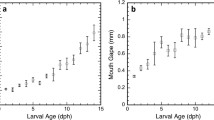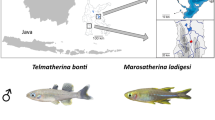Abstract
Competition has broad effects on fish and specifically the effects of competition on the prey capture kinematics and behavior are important for the assessment of future prey capture studies in bony fishes. Prey capture kinematics and behavior in bony fishes have been shown to be affected by temperature and satiation. The densities at which bony fish are kept have also been shown to affect their growth, behavior, prey selection, feeding and physiology. We investigated how density induced intraspecific competition for food affects the prey capture kinematics of juvenile bluegill sunfish, Lepomis macrochirus. High speed video was utilized to film five bold individuals feeding at three different densities representing different levels of intraspecific competition. We hypothesized that: (1) the feeding kinematics will be faster at higher levels of competition compared to lower levels of competition, and (2) bluegill should shift from more suction-based feeding towards more ram-based feeding with increasing levels of competition in order to outcompete conspecifics for a prey item. We found that, with increased intraspecific competition, prey capture became faster, involving more rapid jaw opening and therefore greater inertial suction, shorter mouth closing times, and shorter gape cycles. Furthermore, the attack velocity of the fish increased with increasing competition, however a shift towards primarily ram based feeding was not confirmed. Our study demonstrates that prey capture kinematics are affected by the presence of conspecifics and future studies need to consider the effects of competition on prey capture kinematics.



Similar content being viewed by others
References
Almany GR (2004) Does increased habitat complexity reduce predation and competition in coral reef fish assemblages? Oikos 106:275–284
Anderson D, Saoud IP, Davis A (2002) The effects of stocking density on survival, growth, condition, and feed efficiency of bluegill juveniles. N Am J Aquac 64:297–300
Booth DJ, Beretta GA (2004) Influence of recruit condition on food competition and predation risk in a coral reef fish. Oecologia 140:289–294
Brogowski Z, Siewert H, Keplinger D (2005) Feeding and growth responses of bluegill fish (Lepomis macrochirus) at various pH levels. Pol J Environ Stud 14:517–519
Carroll AM, Wainwright PCH, Huskey SH, Collar DC, Turingan RG (2004) Morphology predicts suction feeding performance in centrarchid fishes. J Exp Biol 207:3873–3881
Day SW, Higham TE, Cheer AY, Wainwright PC (2005) Spatial and temporal flow patterns during suction feeding of bluegill sunfish (Lepomis macrochirus) by particle image velocimetry. J Exp Biol 208:2661–2671
Devries MS, Wainwright PC, Beaupre SJ (2006) The effects of acute temperature change on prey capture kinematics in largemouth bass, Micropterus salmoides. Copeia 2006:437–444
Ehlinger TJ (1990) Habitat choice and phenotype-limited feeding efficiency in bluegill: individual differences and trophic polymorphism. Ecology 7:886–896
Ferry-Graham LA, Wainwright PC, Lauder GV (2003) Quantification of flow during suction feeding in bluegill sunfishes. Zoology 106:159–168
Gillis GB, Lauder GV (1995) Kinematics of feeding in bluegill sunfish: is there a general distinction between aquatic capture and transport behaviors. J Exp Biol 198:709–720
Hasegawa K, Maekawa K (2006) Effect of habitat components on competitive interaction between native white-spotted charr and introduced brown trout. J Freshw Ecol 21:475–480
Higham TE (2007) Feeding, fins and braking maneuvers: locomotion during prey capture in centrarchid fishes. J Exp Biol 210:107–117
Higham TE, Day SW, Wainwright PC (2005a) Sucking while swimming: evaluating the effects of ram speed on suction generation in bluegill sunfish Lepomis macrochirus using digital particle image velocimetry. J Exp Biol 208:2653–2660
Higham TE, Malas B, Jayne BC, Lauder GV (2005b) Constraints on starting and stopping: behavior compensates for reduced pectoral fin area during braking of the bluegill sunfish Lepomis macrochirus. J Exp Biol 208:4735–4746
Higham TE, Day SW, Wainwright PC (2006) The pressures of suction feeding: the relation between buccal pressure and induced fluid speed in centrarchid fishes. J Exp Biol 209:3281–3287
Holzman RA, Wainwright PC (2009) How to surprise a copepod: strike kinematics reduce hydrodynamic disturbance and increase stealth of suction-feeding fish. Limnol Oceanogr 54:2201–2212
Holzman RA, Collar DC, Day RD, Bishop KL, Wainwright PC (2008) Scaling of suction-induced flows in bluegill: morphological and kinematic predictors for the ontogeny of feeding performance. J Exp Biol 2111:2658–2668
Houde ED (1977) Food concentration and stocking density effects on survival and growth of laboratory-reared larvae of bay anchovy Anchoa mitchilli and lined sole Achirus lineatus. Mar Biol 43:333–341
Kahl U, Radke RJ (2006) Habitat and food resource use of perch and roach in a deep mesotrophic reservoir: enough space to avoid competition? Ecol Freshw Fish 15:48–56
Liem KF (1980) Acquisition of energy by teleosts: Adaptive mechanisms and evolutionary patterns. In: Ali MA (ed) Environmental physiology of fishes. Plenum, New York, pp 299–334
Mittelbach GG (1981) Foraging efficiency and body size: a study of optimal diet and habitat use by bluegills. Ecology 62:1370–1386
Nemeth DH (1997a) Modulation of attack behavior and its effect on feeding performance in a trophic generalist fish. J Exp Biol 200:2155–2164
Nemeth DH (1997b) Modulation of buccal pressure during prey capture in Hexagrammos decagrammus (Teleostei: Hexagrammidae). J Exp Biol 200:2145–2154
Norton SF (1991) Capture success and diet of cottid fishes: the role of predator morphology and attack kinematics. Ecology 72:1807–1819
Norton SF, Brainerd EL (1993) Convergence in the feeding mechanics of ecomorphologically similar species in the Centrarchidae and Cichlidae. J Exp Biol 176:11–29
Nyberg DD (1971) Prey capture in the largemouth bass. Am Midl Nat 86:128–144
Osenberg CW, Werner EE, Mittelbach GG, Hall DJ (1988) Growth patterns in bluegill (Lepomis macrochirus) and pumpkinseed (L. gibbosus) sunfish: environmental variation and the importance of ontogenetic niche shifts. Can J Fish Aquat Sci 45:17–26
Plath M, Richter S, Tiedemann R, Schlupp I (2008) Male fish deceive competitors about mating preferences. Curr Biol 18:1138–1141
Porter HT, Motta PJ (2000) A comparison of prey capture behavior and kinematics in three ram feeding fishes. Am Zool 40:1175–1175
Richard BA, Wainwright PC (1995) Scaling the feeding mechanism of largemouth bass (Micropterus salmoides): kinematics of prey capture. J Exp Biol 198:419–433
Sanford CP, Wainwright PC (2002) Use of sonomicrometry demonstrates the link between prey capture kinematics and suction pressure in largemouth bass. J Exp Biol 205:3445–3457
Sass GG, Motta PJ (2002) The effects of satiation on prey capture kinematics in the largemouth bass, Micropterus salmoides. Environ Biol Fish 65:441–454
Savino JF, Marschall EA, Stein RA (1992) Bluegill growth as modified by plant density: an exploration of underlying mechanisms. Oecologia 89:153–160
Schleuter D, Eckmann R (2006) Competition between perch and ruffe: the advantage of turning night into day. Freshw Biol 51:287–297
Stoltz J, Neff B (2006) Male size and mating tactic influence proximity to females during sperm competition in bluegill sunfish. Behav Ecol Sociobiol 59:811–818
Stoner AW, Ottmar ML (2004) Fish density and size alter Pacific halibut feeding: implications for stock assessment. J Fish Biol 64:1712–1724
Taborsky M (1998) Sperm competition in fish: ‘bourgeois’ males and parasitic spawning. Trends Ecol Evol 13:222–227
Van Damme J, Aerts P (1997) Kinematics and functional morphology of aquatic feeding in Australian side-necked turtles (Pleurodira: Chelodina). J Morphol 233:113–125
Wainwright PC, Lauder GV (1986) Feeding biology of sunfishes: patterns of variation in the feeding mechanism. Zool J Linn Soc-Lond 88:217–228
Ward AJW, Webster MM, Hart PJB (2006) Intraspecific food competition in fishes. Fish Fisheries 7:231–261
Webb PW, Skadsen JM (1980) Strike tactics of Esox. Can J Zool 58:1462–1569
Webster MM, Ward AJW, Hart PJB (2009) Individual boldness affects interspecific interactions in sticklebacks. Behav Ecol Sociobiol 63:511–520
Werner EE (1977) Competition and habitat shift in two sunfishes (Centrarchidae). Ecology 58:869–876
Werner EE, Hall DJ (1979) Foraging efficiency and habitat switching in competing sunfishes. Ecology 60:256–264
Wiener JG, Hanneman WR (1982) Growth and condition of bluegills in Wisconsin lakes: effects of population density and lake pH. T Am Fish Soc 111:761–767
Wilson DS, Coleman K, Clark AB, Biederman L (1993) Shy-bold continuum in pumpkinseed sunfish (Lepomis gibbosus): an ecological study of a psychological trait. J Comp Psychol 107:250–260
Wintzer AP, Motta PJ (2004) The effects of temperature on prey capture kinematics of the bluegill sunfish, Lepomis macrochirus: implications for feeding studies. Can J Zool 82:794–799
Acknowledgments
The authors would like to thank the Porter Family Foundation and the University of South Florida Office of Undergraduate Research for funding this research as well as Timothy Higham for offering comments on this manuscript. We also would like to thank Ralph Turingan for his help with the experimental setup, Richard Tankersley for his help with the statistical analysis as well as Kyle Mara, Maria Laura Habegger, Lisa Whitenack, Samantha Mulvany and Tanya Brunner with their help throughout this study.
Author information
Authors and Affiliations
Corresponding author
Rights and permissions
About this article
Cite this article
Pfeiffenberger, J.A., Motta, P.J. The effects of intraspecific competition on the prey capture behavior and kinematics of the bluegill sunfish, Lepomis macrochirus . Environ Biol Fish 93, 13–21 (2012). https://doi.org/10.1007/s10641-011-9885-0
Received:
Accepted:
Published:
Issue Date:
DOI: https://doi.org/10.1007/s10641-011-9885-0




